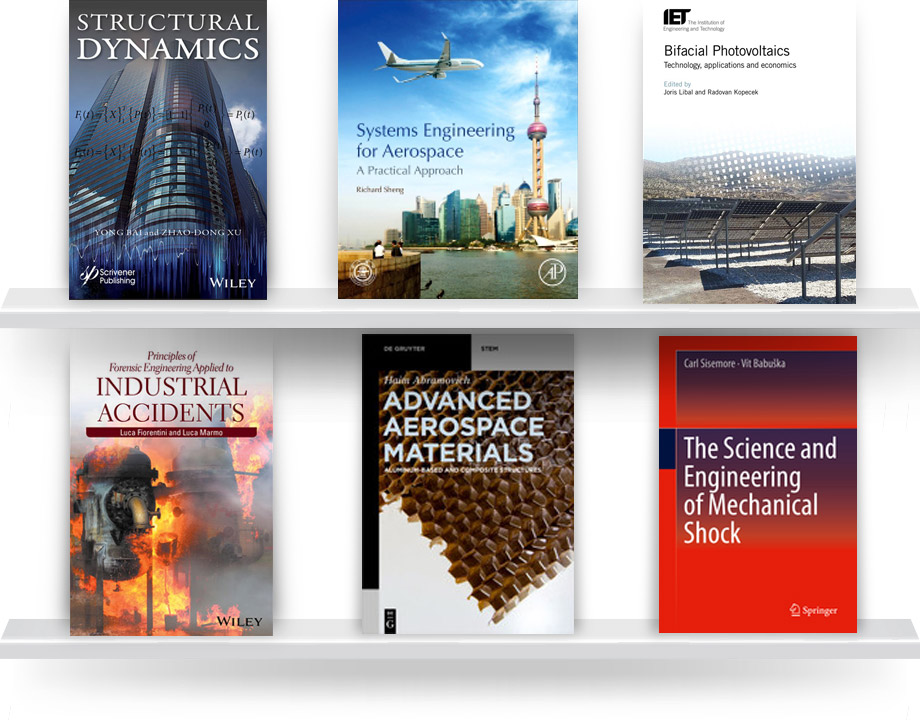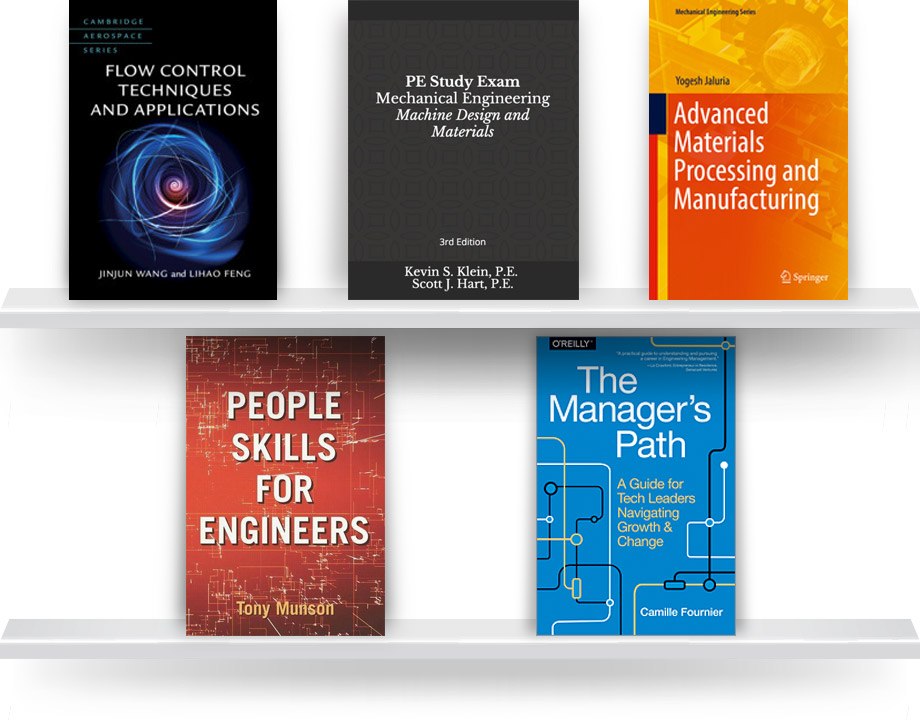11 Best New Books for Mechanical Engineers
11 Best New Books for Mechanical Engineers


These engineering books cover the latest from aerospace to new materials, from forensic engineering to people skills, and more.
No matter how busy your schedule is, sharpening your skills by reading is one of the easiest ways to learn about new engineering developments, done on your own schedule.
These 11 recently published engineering books are great resources for students and for mechanical engineers who want to stay current on emerging technologies, materials, design, and professional development.
Structural Dynamics by Yong Bai and Zhao-Dong Xu
Wiley-Scrivener, 2019
Fully understanding and eliminating dynamic problems involving structures is critical for high performance and safety. This book discusses basic theories and concepts of structural dynamics, including equation of motion, single-degree and multi-degree of freedom systems, distributed-parameter systems, stochastic structural vibrations, and research projects of structural dynamics.
Systems Engineering for Aerospace: A Practical Approach by Richard Sheng
Academic Press, 2019
This book describes how to measure and manage aircraft programs from start to finish. Real-world examples of challenging situations and solutions will help aerospace engineers to learn how to simplify aircraft design and develop a lifecycle strategy using the Integrated Master Plan/Schedule (IMP/IMS) process that improves quality and reduces costs.
Bifacial Photovoltaics: Technology, Applications and Economics by Joris Libal and Radovan Kopecek
The Institution of Engineering and Technology, 2018
Bifacial photovoltaic (PV) modules are unique in that they utilize light from both sides and can therefore significantly increase the amount of electricity generated, compared to standard PV modules. There is, however, a lack of comprehensive, up-to-date information on this topic—until now. This books provides a thorough review of bifacial photovoltaics, with a focus on crystalline silicon technology.
Principles of Forensic Engineering Applied to Industrial Accidents by Luca Fiorentini and Luca Marmo
Wiley, 2019
Forensic engineering is an investigative process that results in discovering the causes of an accident or its near miss. In order to keep potentially dangerous failures from happening again in future projects, it’s absolutely critical to understand the critical flaws in thinking or design that lead to these problems in the first place. This book’s authors provide numerous real-life case studies that illustrate forensic engineering methods.
Advanced Aerospace Materials: Aluminum-Based and Composite Structures by Haim Abramovich
De Gruyter, 2019
This book provides an overview of aerospace materials and how they are used in the design and manufacturing of aircraft and spacecraft. Various aspects of design, failure, and monitoring of structural components are discussed, including relevant formulas and analyses. Other topics covered in the book are fatigue, crack propagation, vibration and buckling, optimization of thin-walled structures, and structural health monitoring.
The Science and Engineering of Mechanical Shock by Carl Sisemore and Vit Babuska
Springer, 2019
Mitigating the potential for shock is extremely important in aerospace, civil, naval, and mechanical systems. The authors explain how to identify potential shock environments using the latest diagnostic tools, including non-spectral methods. Development of single-degree-of-freedom theory and the theory of the shock response spectra are also discussed.
Flow Control Techniques and Applications by Jinjun Wang and Lihao Feng
Cambridge University Press, 2018
This comprehensive guide to various flow control techniques discusses approaches such as the vortex generator, biological techniques, the jet and synthetic jet, the plasma actuator, and closed-loop control. An overview of the discipline of flow control is presented, as well as the characteristics and control mechanisms for each technique.
PE Study Exam: Mechanical Engineering: Machine Design and Materials by Kevin Klein and Scott Hart
Independently published, 2019
Klein and Scott are two professional engineers who took and passed the first revision of the updated 2017 PE exam for Mechanical Engineering: Machine Design and Materials. They created this 80-question practice exam to help other engineers prepare for the exam. “Most of the materials we used to study had practice problems that were too complicated or led us to study unnecessary concepts,” they write. “We present material that we wish we had while studying for the exam.”
Advanced Materials Processing and Manufacturing by Yogesh Jaluria
Springer, 2018
Advanced materials are a rapidly developing field across a wide range of manufacturing sectors. The author discusses the advanced processing of new and emerging materials and how they are used in manufacturing systems. Topics discussed include fiber optics, polymeric and composite materials, alloys, microscale components, and processes for prediction, design, and optimization.
People Skills for Engineers by Tony Munson
Independently published, 2018
Few engineers receive people-skills training as students or professionals. As a result, many engineers struggle with interpersonal challenges while working alongside other people. This book is intended to help engineers solve their communications problems and improve relationships with co-workers and managers. “I instantly recognized some ‘difficult engineer’ behaviors I was guilty of myself,” writes a reviewer. “The author gives real-world, practical advice that can be used to immediately start improving your people skills.”
The Manager's Path: A Guide for Tech Leaders Navigating Growth and Change by Camille Fournier
O’Reilly Media, 2017
A recent survey by Managers Club asked over 65 engineering leaders to recommend just one book for developing excellent management skills—a transition that is often difficult for mechanical engineers. This book was the top choice. Fournier discusses ways of being a good mentor, managing yourself and multiple teams, and building a team culture. “Each chapter represents another step in the, well… manager’s path, which makes it immediately useful for anyone regardless of where they are in that path,” notes a review by a director of engineering. “It’s almost an encyclopedia of management.”
You May Also Like: 3 Books All Mechanical Engineers Must Read
Mark Crawford is a technology writer based in Madison, Wis.
These 11 recently published engineering books are great resources for students and for mechanical engineers who want to stay current on emerging technologies, materials, design, and professional development.
Structural Dynamics by Yong Bai and Zhao-Dong Xu
Wiley-Scrivener, 2019
Fully understanding and eliminating dynamic problems involving structures is critical for high performance and safety. This book discusses basic theories and concepts of structural dynamics, including equation of motion, single-degree and multi-degree of freedom systems, distributed-parameter systems, stochastic structural vibrations, and research projects of structural dynamics.
Systems Engineering for Aerospace: A Practical Approach by Richard Sheng
Academic Press, 2019
This book describes how to measure and manage aircraft programs from start to finish. Real-world examples of challenging situations and solutions will help aerospace engineers to learn how to simplify aircraft design and develop a lifecycle strategy using the Integrated Master Plan/Schedule (IMP/IMS) process that improves quality and reduces costs.
Bifacial Photovoltaics: Technology, Applications and Economics by Joris Libal and Radovan Kopecek
The Institution of Engineering and Technology, 2018
Bifacial photovoltaic (PV) modules are unique in that they utilize light from both sides and can therefore significantly increase the amount of electricity generated, compared to standard PV modules. There is, however, a lack of comprehensive, up-to-date information on this topic—until now. This books provides a thorough review of bifacial photovoltaics, with a focus on crystalline silicon technology.
Principles of Forensic Engineering Applied to Industrial Accidents by Luca Fiorentini and Luca Marmo
Wiley, 2019
Forensic engineering is an investigative process that results in discovering the causes of an accident or its near miss. In order to keep potentially dangerous failures from happening again in future projects, it’s absolutely critical to understand the critical flaws in thinking or design that lead to these problems in the first place. This book’s authors provide numerous real-life case studies that illustrate forensic engineering methods.
Advanced Aerospace Materials: Aluminum-Based and Composite Structures by Haim Abramovich
De Gruyter, 2019
This book provides an overview of aerospace materials and how they are used in the design and manufacturing of aircraft and spacecraft. Various aspects of design, failure, and monitoring of structural components are discussed, including relevant formulas and analyses. Other topics covered in the book are fatigue, crack propagation, vibration and buckling, optimization of thin-walled structures, and structural health monitoring.
The Science and Engineering of Mechanical Shock by Carl Sisemore and Vit Babuska
Springer, 2019
Mitigating the potential for shock is extremely important in aerospace, civil, naval, and mechanical systems. The authors explain how to identify potential shock environments using the latest diagnostic tools, including non-spectral methods. Development of single-degree-of-freedom theory and the theory of the shock response spectra are also discussed.
Flow Control Techniques and Applications by Jinjun Wang and Lihao Feng
Cambridge University Press, 2018
This comprehensive guide to various flow control techniques discusses approaches such as the vortex generator, biological techniques, the jet and synthetic jet, the plasma actuator, and closed-loop control. An overview of the discipline of flow control is presented, as well as the characteristics and control mechanisms for each technique.
PE Study Exam: Mechanical Engineering: Machine Design and Materials by Kevin Klein and Scott Hart
Independently published, 2019
Klein and Scott are two professional engineers who took and passed the first revision of the updated 2017 PE exam for Mechanical Engineering: Machine Design and Materials. They created this 80-question practice exam to help other engineers prepare for the exam. “Most of the materials we used to study had practice problems that were too complicated or led us to study unnecessary concepts,” they write. “We present material that we wish we had while studying for the exam.”
Advanced Materials Processing and Manufacturing by Yogesh Jaluria
Springer, 2018
Advanced materials are a rapidly developing field across a wide range of manufacturing sectors. The author discusses the advanced processing of new and emerging materials and how they are used in manufacturing systems. Topics discussed include fiber optics, polymeric and composite materials, alloys, microscale components, and processes for prediction, design, and optimization.
People Skills for Engineers by Tony Munson
Independently published, 2018
Few engineers receive people-skills training as students or professionals. As a result, many engineers struggle with interpersonal challenges while working alongside other people. This book is intended to help engineers solve their communications problems and improve relationships with co-workers and managers. “I instantly recognized some ‘difficult engineer’ behaviors I was guilty of myself,” writes a reviewer. “The author gives real-world, practical advice that can be used to immediately start improving your people skills.”
The Manager's Path: A Guide for Tech Leaders Navigating Growth and Change by Camille Fournier
O’Reilly Media, 2017
A recent survey by Managers Club asked over 65 engineering leaders to recommend just one book for developing excellent management skills—a transition that is often difficult for mechanical engineers. This book was the top choice. Fournier discusses ways of being a good mentor, managing yourself and multiple teams, and building a team culture. “Each chapter represents another step in the, well… manager’s path, which makes it immediately useful for anyone regardless of where they are in that path,” notes a review by a director of engineering. “It’s almost an encyclopedia of management.”
You May Also Like: 3 Books All Mechanical Engineers Must Read
Mark Crawford is a technology writer based in Madison, Wis.







